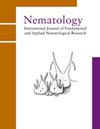Automated classification and tracking of microscopic holographic patterns of nematodes using machine learning methods
IF 1.1
4区 生物学
Q2 ZOOLOGY
引用次数: 0
Abstract
Analysing nematode behaviour helps estimate biomechanical parameters for applications like cellular biology, pharmacology and cognitive neuroscience. Portable holographic platforms offer cost-effective, high-resolution, high-frame-rate, wide-field imaging compared to conventional microscopy. Holographic methods can reconstruct original shapes using numerical diffraction, although this is computationally expensive. However, video holography remains challenging due to the fast motion and overlapping of holograms when nematodes swim in crowded environments. In this work we address this problem by focusing on automated detection and tracking of nematodes in densely populated environments, using machine learning methods. The main advantage of our approach is to present an automated computational flow to detect and analyse the behaviour of live nematodes in video directly from the raw holographic signals, without the requirement of phase-recovering methods for diffraction. For this purpose, we developed a three-step CNN-based approach consisting of: i) nematode hologram detection; ii) temporal tracking; and iii) behavioural analysis based on mobility parameters. In terms of precision, the obtained results show that using a two-stage detector, the Faster R-CNN architecture with the ResNet18 model as a backbone, presented the best Mean Average Precision (mAP) score with 86% for correct classification. For tracking, the best performing algorithm was IoU with a HOTA, resulting in 62.42% when applied on the individually tagged nematodes, which is comparable to the best current generic multi-tracking approaches available over the literature. Our obtained results show that the use of a convolutional neural network approach associated with a classic tracking algorithm is a very suitable approach for nematode detection and behavioural analysis for biological assays directly from holograms, even in densely populated environments. The proposed approach has been presented as a promising solution for automated inspection of free-living nematode individuals.利用机器学习方法对线虫的显微全息图案进行自动分类和跟踪
分析线虫的行为有助于估计细胞生物学、药理学和认知神经科学等应用的生物力学参数。与传统显微镜相比,便携式全息平台提供成本效益高、高分辨率、高帧率、宽视场成像。全息方法可以使用数值衍射重建原始形状,尽管这在计算上是昂贵的。然而,当线虫在拥挤的环境中游动时,由于全息图的快速运动和重叠,视频全息术仍然具有挑战性。在这项工作中,我们通过使用机器学习方法,专注于在人口密集的环境中自动检测和跟踪线虫来解决这个问题。我们的方法的主要优点是提供了一个自动化的计算流程,直接从原始全息信号中检测和分析视频中活线虫的行为,而不需要衍射的相位恢复方法。为此,我们开发了一种基于cnn的三步方法,包括:i)线虫全息图检测;Ii)时间跟踪;iii)基于流动性参数的行为分析。在精度方面,得到的结果表明,使用两级检测器,以ResNet18模型为骨干的Faster R-CNN架构的平均平均精度(mAP)得分最高,为86%。在跟踪方面,性能最好的算法是带有HOTA的IoU算法,当应用于单个标记的线虫时,其跟踪率为62.42%,与目前文献中可用的最佳通用多跟踪方法相当。我们获得的结果表明,使用卷积神经网络方法与经典跟踪算法相关联是一种非常适合的方法,可以直接从全息图中进行线虫检测和行为分析,即使在人口稠密的环境中也是如此。所提出的方法已被提出作为一个有前途的解决方案,自动检查自由生活的线虫个体。
本文章由计算机程序翻译,如有差异,请以英文原文为准。
求助全文
约1分钟内获得全文
求助全文
来源期刊

Nematology
生物-动物学
CiteScore
2.60
自引率
33.30%
发文量
67
审稿时长
3 months
期刊介绍:
Nematology is an international journal for the publication of all aspects of nematological research (with the exception of vertebrate parasitology), from molecular biology to field studies. Papers on nematode parasites of arthropods, and on soil free-living nematodes, and on interactions of these and other organisms, are particularly welcome. Research on fresh water and marine nematodes is also considered when the observations are of more general interest.
Nematology publishes full research papers, short communications, Forum articles (which permit an author to express a view on current or fundamental subjects), perspectives on nematology, and reviews of books and other media.
 求助内容:
求助内容: 应助结果提醒方式:
应助结果提醒方式:


